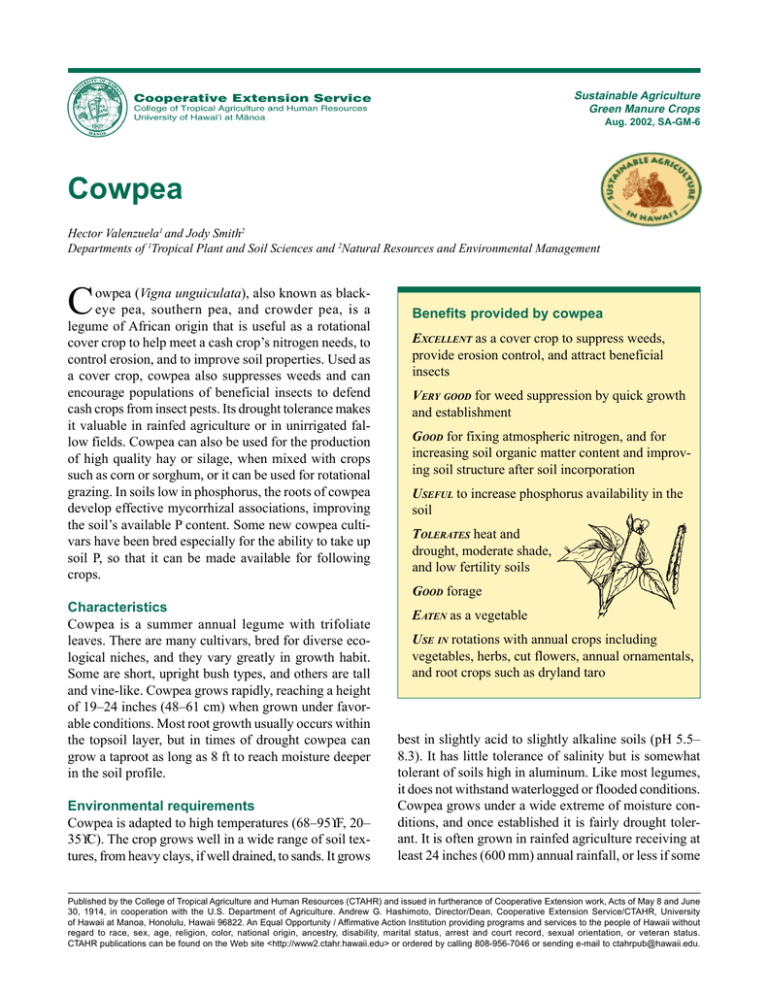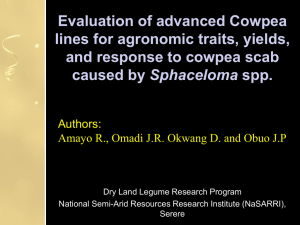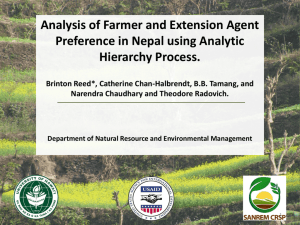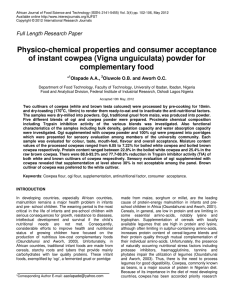Cowpea
advertisement

Sustainable Agriculture Green Manure Crops Aug. 2002, SA-GM-6 Cowpea Hector Valenzuela1 and Jody Smith2 Departments of 1Tropical Plant and Soil Sciences and 2Natural Resources and Environmental Management C owpea (Vigna unguiculata), also known as blackeye pea, southern pea, and crowder pea, is a legume of African origin that is useful as a rotational cover crop to help meet a cash crop’s nitrogen needs, to control erosion, and to improve soil properties. Used as a cover crop, cowpea also suppresses weeds and can encourage populations of beneficial insects to defend cash crops from insect pests. Its drought tolerance makes it valuable in rainfed agriculture or in unirrigated fallow fields. Cowpea can also be used for the production of high quality hay or silage, when mixed with crops such as corn or sorghum, or it can be used for rotational grazing. In soils low in phosphorus, the roots of cowpea develop effective mycorrhizal associations, improving the soil’s available P content. Some new cowpea cultivars have been bred especially for the ability to take up soil P, so that it can be made available for following crops. Benefits provided by cowpea EXCELLENT as a cover crop to suppress weeds, provide erosion control, and attract beneficial insects VERY GOOD for weed suppression by quick growth and establishment GOOD for fixing atmospheric nitrogen, and for increasing soil organic matter content and improving soil structure after soil incorporation USEFUL to increase phosphorus availability in the soil TOLERATES heat and drought, moderate shade, and low fertility soils GOOD forage Characteristics Cowpea is a summer annual legume with trifoliate leaves. There are many cultivars, bred for diverse ecological niches, and they vary greatly in growth habit. Some are short, upright bush types, and others are tall and vine-like. Cowpea grows rapidly, reaching a height of 19–24 inches (48–61 cm) when grown under favorable conditions. Most root growth usually occurs within the topsoil layer, but in times of drought cowpea can grow a taproot as long as 8 ft to reach moisture deeper in the soil profile. Environmental requirements Cowpea is adapted to high temperatures (68–95°F, 20– 35°C). The crop grows well in a wide range of soil textures, from heavy clays, if well drained, to sands. It grows EATEN as a vegetable USE IN rotations with annual crops including vegetables, herbs, cut flowers, annual ornamentals, and root crops such as dryland taro best in slightly acid to slightly alkaline soils (pH 5.5– 8.3). It has little tolerance of salinity but is somewhat tolerant of soils high in aluminum. Like most legumes, it does not withstand waterlogged or flooded conditions. Cowpea grows under a wide extreme of moisture conditions, and once established it is fairly drought tolerant. It is often grown in rainfed agriculture receiving at least 24 inches (600 mm) annual rainfall, or less if some Published by the College of Tropical Agriculture and Human Resources (CTAHR) and issued in furtherance of Cooperative Extension work, Acts of May 8 and June 30, 1914, in cooperation with the U.S. Department of Agriculture. Andrew G. Hashimoto, Director/Dean, Cooperative Extension Service/CTAHR, University of Hawaii at Manoa, Honolulu, Hawaii 96822. An Equal Opportunity / Affirmative Action Institution providing programs and services to the people of Hawaii without regard to race, sex, age, religion, color, national origin, ancestry, disability, marital status, arrest and court record, sexual orientation, or veteran status. CTAHR publications can be found on the Web site <http://www2.ctahr.hawaii.edu> or ordered by calling 808-956-7046 or sending e-mail to ctahrpub@hawaii.edu. SA- GM-6 Green Manure Crops: Cowpea minimal irrigation is available. In Hawaii, cowpea grows year-round at elevations ranging from sea level to 1000 ft. At higher elevations (up to 2000 ft), planting should be limited to the warmer spring and summer months, according to the USDA Natural Resources Conservation Service (NRCS). Cultivars The cowpea cultivar commonly recommended by the Hawaii NRCS is ‘Mississippi Pinkeye Purple Hull’, which is reported to be resistant to root-knot nematode and susceptible to burrowing nematodes. Another older cultivar with reported nematode resistance, ‘Iron and Clay’, also does well in Hawaii. Newer cultivars may become available with improved disease and nematode resistance. Currently, resistance has been bred against several strains of Fusarium wilt and the root-knot nematodes M. incognita and M. javanica. Establishment Broadcast 70–120 lb pure live seed per acre, or drill 30– 90 lb pure live seed per acre. Broadcast and cover with a light disking, or drill to a depth of 1–11⁄2 inches (2.5– 3.8 cm). For good germination, soil temperature should be above 70°F (20°C). When planting cowpea where it has not been grown before, treat the seeds with a rhizobia inoculant to ensure that the plants develop a nitrogen-fixing symbiosis. The “cowpea-type” rhizobia bacteria (a Bradyrhizobium species) is found in most soils, but it may be lacking or in very low numbers in soils of areas receiving <20 inches (500 mm) of rainfall, or in the soil of newly abandoned sugarcane or pineapple fields. After the initial inoculation, the rhizobia will persist in the soil for years, so seed inoculation of subsequent cowpea crops is not necessary. CTAHR — Aug. 2002 tage of the natural ability of cowpea and other legumes to fix atmospheric nitrogen. For good legume growth and nitrogen fixation, the soil should have adequate phosphorus, a good balance of micronutrients (iron, sulfur, and molybdenum), appropriate pH, and good aeration (no compaction or waterlogging). Cowpea is sensitive to zinc deficiency. The N contribution to a cropping system by a cowpea cover crop is about 130 lb/acre if the crop is turned under. Additional significant benefits resulting from incorporation of cowpea organic matter into the soil include improved soil structure, water infiltration, and soil water-holding capacity. Organic matter will also increase the ability of the soil to hold plant nutrients by improving the soil cation exchange capacity. Organic matter provided by legumes is quickly decomposed by soil microorganisms and does not persist for long in the soil. To build up the humus content of the soil, select slowly decomposing, fibrous grasses as green manure, or use grass-legume mixtures. Possible grasses for mixture with cowpea include sorghum-sudangrass hybrids and buckwheat. Long-term incorporation of annual legumes such as cowpea will increase the soil humus content, but at a slower rate than would grass cover crops. The cowpea root system also has a beneficial effect on the structure and tilth of the topsoil layer. Cowpea’s quick canopy growth also makes it ideal to minimize erosion on sloping fields. Weed control Cowpea grows quickly and will shade and smother weeds, or it may outcompete them for soil moisture and nutrients. In demonstration plantings at the Waimanalo Research Station, cowpea was comparable to rhodesgrass as a weed-suppressing cover, as shown in Table 1. Attract beneficial insects Uses Soil improvement Cowpea can produce about 2 tons of dry matter per acre, each ton containing about 60 lb of nitrogen, according to the NRCS. When grown during the winter for about 40 days at CTAHR’s low elevation Waimanalo Research Station on Oahu, the 9-inch tall stand had above-ground fresh weight of about 6000 lb/acre. The nitrogen content of cowpea is about 1.5%. Farmers can take advan- 2 Cowpea has extrafloral nectaries on its petioles and leaflets; these nourish beneficial insects such as honeybees, lady beetles, predatory wasps, ants, and soft-winged beetles. Feed and food Cowpea grown to maturity can be used as a feed (grazed or harvested for fodder), or its pods can be harvested and eaten as a vegetable. The beans are nutritious and provide complementary proteins to cereals. Some people SA- GM-6 Green Manure Crops: Cowpea Table 1. Weed control by cover crops during establishment and after mowing at Waimanalo, Oahu. Weed cover (% of area) Cowpea Rhodesgrass Mustard Bare ground In the cover crop Two months after mowing 13 10 25 74 40 70 63 eat both the fresh pods and leaves, and the dried seeds are popular ingredients in a variety of dishes in the southern USA. In other countries, cowpea is often grown in polyculture with a wide variety of other crops including cassava, corn, sorghum, sudangrass, johnsongrass, millet, peanut, and soybean. Pest problems Cowpea is a hardy crop but it hosts many pests that attack vegetables, including leafminers, whiteflies, leafhoppers, mites, thrips, and aphids. Cowpea’s attraction for insects may be an advantage if the planting also attracts a sizable population of beneficial insects, but it is not if pest outbeaks occur and then move on to attack a cash crop. If allowed to form pods, cowpea may also attract stinkbugs. To prevent stinkbug outbreaks, flail mow or incorporate cowpeas prior to pod set. Careful weekly monitoring is important to ensure that the cowpea planting is not becoming a source of pests on the farm. Cowpea is also susceptible to diseases that affect legumes. Damping-off may occur on seedlings under moist conditions and in dense plantings. Root rot and stem rot may also be a problem. Cowpea is susceptible to powdery mildew (Erysiphe polyqoni) during wet winter months and under humid conditions. Other diseases that affect cowpea include anthracnose (Colletotrichum CTAHR — Aug. 2002 lindemuthianum), charcoal rot (Sclerotium bataticola), and fusarium wilt (Fusarium oxysporum vr. tracheiphilum). In the establishment phase, rodents and birds can be important pests by feeding on the seeds. For assistance: Contact your nearest Cooperative Extension Service office for additional assistance in selecting appropriate cover crops and green manures for your farm and cropping situation. Help can also be obtained from the USDA Natural Resources Conservation Service field offices located on each island. Visit CTAHR’s Sustainable Agriculture for Hawaii Program Website at <http://www.ctahr.hawaii.edu/ sustainag> to find additional information about green manure and cover crops. The site also includes references and links to other useful on-line resources. Sustainable Agriculture in Hawaii . . . . . . integrates three main goals—environmental health, economic profitability, and social and economic equity. Sustainable farms differ from conventional ones in that they rely more on management practices such as crop diversification and crop rotation, agroforestry, integrated pest management, rotational grazing, and innovative marketing strategies. For further information on Sustainable Agriculture in Hawaii, contact: Dr. Richard Bowen, Hawaii SARE Program Coordinator phone (808) 956-8708 e-mail: <rbowen@hawaii.edu> <http://www.ctahr.hawaii.edu/sustainag/> This material is based on work supported by the Cooperative State Research, Education, and Extension Service, U.S. Department of Agriculture, and the Agricultural Experiment Station, Utah State University, under Cooperative Agreement 98-ESAG-1-0340. Portions of this text were adapted from the USDA Natural Resources Conservation Service Hawaii Field Office Technical Guide, Section IV, Code 340, “Cover and Green Manure Crop” May 1992. Plant drawing reprinted from Managing Cover Crops Profitably, 2nd edition, published by USDA’s Sustainable Agriculture Network (SAN), original illustration by Marianne Sarrantonio and Elayne Sears. Logo drawing courtesy of Deitrich Varez. 3






